Harriet Hubbard Ayer
Continue to: Harriet Hubbard Ayer (post 1947)
In 1896, the Recamier Manufacturing Company went into receivership. Although it had been established by Harriet Hubbard Ayer in 1886, she had lost control of the company in 1893.
See also: Recamier Manufacturing Company
At the receiver sale Recamier’s assets were bought for US$4,000 by a former employee, Maria E. Rinn. She continued the business using Harriet Hubbard Ayer’s name until Ayer brought a suit against her. In 1897, the case was settled out of court when Rinn signed an affidavit stating that she would stop doing this.
In 1903, Harriet Hubbard Ayer died from pneumonia and her youngest daughter, Margaret Hubbard Ayer [1877-1965], sold her mother’s name to Vincent Benjamin Thomas, a Wall Street coffee broker. Exactly when this happened is open to question; it may have been as early as 1904 or as late as 1906. The link between Thomas and Ayer may have come through Lillian Sefton, whom Thomas married in 1905. Lillian knew Margaret as both women were professional singers and had worked together in 1903 in New York musical ‘Red Feather’; Margaret, a contralto, taking the role of Daphne, Lillian, a soprano, playing Prada.
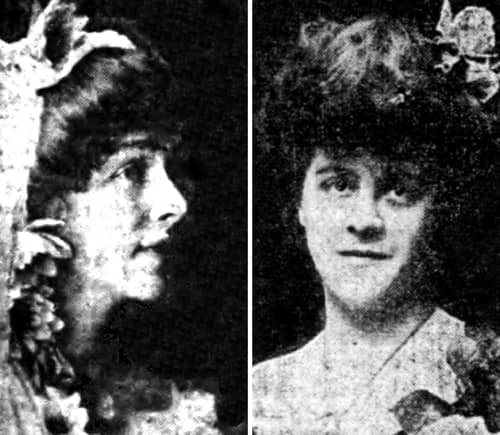
Above: Margaret Hubbard Ayer (left) and Lillian Sefton (right) as they would have been when performing in the ‘Red Feather’.
In 1907, Thomas used the name he acquired from Margaret to establish the Harriet Hubbard Ayer Company with himself as its president and treasurer, and Margaret Hubbard Ayer as secretary.
How involved Margaret Hubbard Ayer was with the new company is not clear. She was listed as the secretary of the company until at least 1918, the year Vincent Thomas died and his wife took over the business. Like her mother, Margaret wrote syndicated newspaper articles on the subject of beauty for the ‘New York World’ newspaper so her expertise and experience in this area would have been useful. Her marriage to Frank Irving Cobb [1869-1923], the editor of the ‘New York World’ newspaper helped make her economically secure even after she was made a widow in 1923, until the crash of 1929 wiped out her investments. Her impoverished status after this, which required her to go back to work, suggests that she was not receiving income from Harriet Hubbard Ayer by then.
Early preparations
Margaret Hubbard Ayer was said to have provided the new company with a number of cosmetic recipes and these may have been used to create some of the initial lines. In 1908, Woodward & Lothrop, a Washington, D.C. department store, advertised a number of Harriet Hubbard Ayer Toilet Preparations including: Cold Cream, Luxuria, Face Powder, Wrinkle Eradicator, Face Cream, Skin and Tissue Builder, Eau de Beaute, Complexion Balm, Moth and Freckle Lotion, Toilet Water, La Belle Coquette Liquid Rouge, Complexion Brushes and Soap.
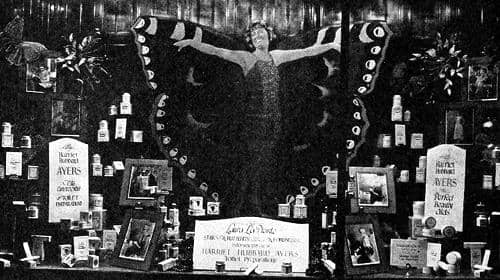
Above: 1924 Window display by the Owl Drug Company, Los Angeles. featuring Laura La Plante, star of Butterfly Pictures, endorsing Harriet Hubbard Ayer Toilet Preparations.
By the end of the 1920s the Harriet Hubbard Ayer range included perfumes, toilet waters, talcum powders, hair shampoos and tonics, soaps, bath salts, nail cosmetics and manicure implements along with the following preparations:
Luxuria Cream: “The ideal cream for sunburn, windburn, chapped face, lips or hands”.
Face Cream: “Will whiten the skin and make it smooth and soft”.
Almond Honey and Cucumber Lotion: “An emollient of unusual excellence for whitening and softening the face, neck and arms; relieving roughness. etc.”
Ayeristocrat Finishing Vanishing Cream: “Relieves skin irritations, tan, sunburn, chapped lips, face and hands; positively will not grow hair; an ideal finishing cream and foundation for powder”.
Eau de Beaute: “A delightful, fragrant, antiseptic face astringent for oily skin, enlarged pores and for firming and strengthening flaccid or relaxed tissues”.
Massage Cream: “A developing cream for the skin and tissues”.
Coeur de Violette Cerate: “A special cream for skin irritations”.
Winkle Eradicator: “Assists in eradicating wrinkles”.
Skin Whitener: “Particularly to be used in the evenings. It creates the much desired beautiful alabaster effect, with resulting benefit to the skin”.
Face Powder: “Delightfully perfumed and of the finest quality”. Shades: Flesh, White, Pink, Rachel, Naturelle, Blanche and Rose.
Theatrical Face Powder: “The widespread popularity of this powder is very particularly deserved. It is rather a heavy powder and possesses unusual adherent qualities”. Shades: Flesh, White, Pink and Rachel.
Service Talcum: “A very popular talcum, particularly among men for use after shaving”.
Complexion Balm and Liquid Face Powder: “An exquisite, fragrant lotion for beautifying the face and neck”.
Moth and Freckle Lotion and Face Bleach: “For bleaching the skin and the relief of freckles”.
Lotion de Fraise: “For bleaching the skin and the relief of freckles … It acts as a distinct tonic for the skin and its further effect is that of a mild astringent”.
Lemon Lotion: “This lotion contains the real juice of the ripe lemon. No oil of lemon is used in its manufacture. For cleansing, bleaching and softening the skin. Men will find it refreshing after shaving”.
Hand Lotion: “For refining and bleaching the hands, unequalled for chapped or rough hands”.
Brilliantine: “For making the hair soft, brilliant and glossy”.
Bandoline: “For producing a beautiful wave in your hair without the use of hot irons”.
Deodorizer: “A substitute for dress shields, neutralizes the odor of perspiration”.
Lip Sticks: “Delightfully perfumed”. Shades: Light, Medium, Medium and White.
Purmasque (Mascarol): “Three shades for the eyebrows and eyelashes”. Shades: Black, Brown and Blonde.
Rouge and Powder Compactes: Shades: Dark Rose, Medium Rose and Bleach.
Bath Salts: “Comes in four scents and colors—Eau de Cologne, Eau de Vervene, Rose, Geranium and Coeur de Violette”.
By 1925, when Lillian married Robert Leftwich Dodge [1872-1940] – who joined the firm as its artistic director – the United States Federal Trade Commission (FTC) listed Harriet Hubbard Ayer as the third largest manufacture of cosmetics in the United States.
In the 1920s, from its base at 317-323 East 34th Street, New York, Harriet Hubbard Ayer expanded overseas. An outlet was operating at 33 Boulevard Haussmann, Paris by 1924 and Sefton-Dodge Ltd. was established at 150 Regent Street, London in 1928. The business name of the London company was changed to Harriet Hubbard Ayer, Ltd. in 1930, the same year operations were moved to 130 Regent Street. A subsidiary was not established in Canada until 1933, when a branch was opened at 480 Lagauchetiere Street, Montreal. Presumably, Canada had been supplied directly from the United States until then.
In the more taxing economic conditions of the 1930s, Harriet Hubbard Ayer underwent some major changes, the most important being the decision in 1932 to start selling direct to retailers, rather than working through wholesalers. The company commissioned more advertising and, like many other cosmetic companies in the depression, modernised its product packaging (1933). It also began opening salons for the first time following the practice of firms like Helena Rubinstein, Elizabeth Arden, and Dorothy Gray.
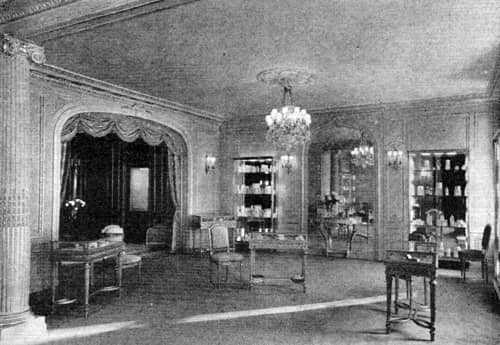
Above: 1930 Harriet Hubbard Ayer salon at 130 Regent Street London. Although referred to as a salon I think this is better called a showroom as I do not believe that beauty services were offered here until 1936 by which time an Institut de Beauté had also been established in Paris.
Earlier in the decade Harriet Hubbard Ayer had been forced to defend its ownership of the Harriet Hubbard Ayer name. In 1920, the Recamier Manufacturing Company had changed hands with Anna E. Reynolds becoming the new owner. Recamier sold a limited range of products until it was reorganised as a New York based corporation and began to make a full line of cosmetics. The new corporation wanted to use the Harriet Hubbard Ayer name and signature and took Harriet Hubbard Ayer, Inc. to court. The Recamier Manufacturing Company lost the case and does not appear to have recovered from the defeat.
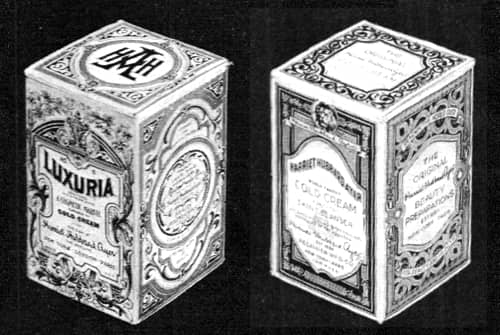
Above: 1931 Harriet Hubbard Ayer Luxuria Cold Cream (left) and Recamier Manufacturing Company Harriet Hubbard Ayer Cold Cream (right). Both boxes use the Harriet Hubbard Ayer name and signature.
Skin-care
The 1930s skin-care routines suggested by Harriet Hubbard Ayer followed the generally accepted principles of the day. Cleansing was of prime importance but as Luxuria Cleansing Cream was considered superior to soap and water, the use of soap was restricted to clients with oily skin.
LUXURIA CLEANSING CREAM should be used freely every night and morning, and whenever you ordinarily freshen your skin during the day. It will seep deep into the pores and dislodge those tiny particles of dirt and impurities that are far beyond the reach of soap and water, bringing them all to the surface where they can be wiped away.
(Harriet Hubbard Ayer Ltd., 1934, p. 9)
The appearance of age lines and the loss of a youthful contour were put down to reduced muscle firmness and general wasting of the tissues, standard ideas of the time. The treatment for this was to combine a skin food to ‘feed the tissues’ with massage movements to ‘exercise the muscles’ and boost circulation.
A rich, life-giving skin cream must be given to it generously and regularly, and massaged in gently so that the dormant muscles may be strengthened, the circulation assisted and waste tissue replenished; the hollows filled out and the flesh of the face and neck made firm and young again. This is what is accomplished by the wholesome SKIN AND TISSUE CREAM, which contains ingredients that are closely allied to the natural fat of the body and therefore rich with benefits to the underlying tissue.
(Harriet Hubbard Ayer Ltd., 1934, pp. 10-11)
To ensure that women correctly massaged the Skin and Tissue Cream into their skin, Harriet Hubbard Ayer provided them with detailed instructions on how to do a facial massage at home.
See also: Skin Foods and Massage, Wrinkles and Double Chins
All of the Harriet Hubbard Ayer night skin-care routines – for normal, oily, dry or combination skin – started with Luxuria Cleansing Cream followed by Skin and Tissue Cream. Most morning routines also began by cleansing with Luxuria, the exception being women with an oily skin who were recommended to use Liquifying Cream instead, a common practice for oily skins in the 1930s. Cleansing was followed with an astringent to ‘close the pores’ – either Eau de Beauté or Special Astringent – and then a powder base was applied unless the skin was oily.
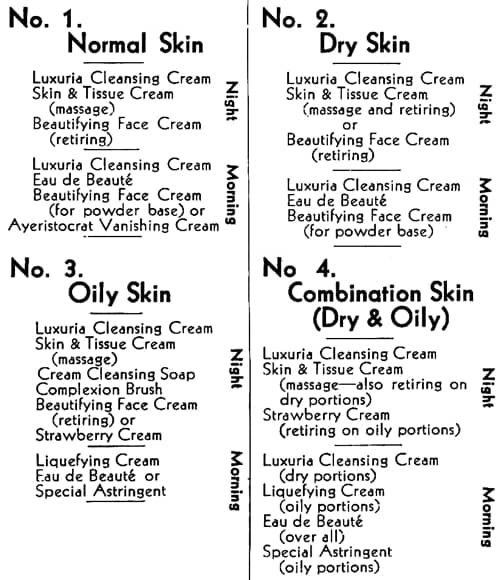
Above: 1934 Harriet Hubbard Ayer skin-care routines for normal, dry, oily and combination skin.
See also: Liquefying Cleansing Creams
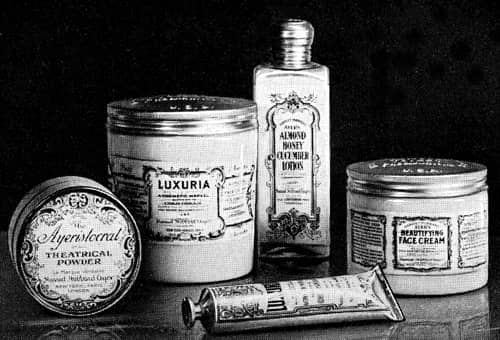
Above: 1931 Harriet Hubbard Ayer Ayeristocrat Theatrical Face Powder, Luxuria (jar and tube) Almond Honey Cucumber Lotion, and Beautifying Face Cream.
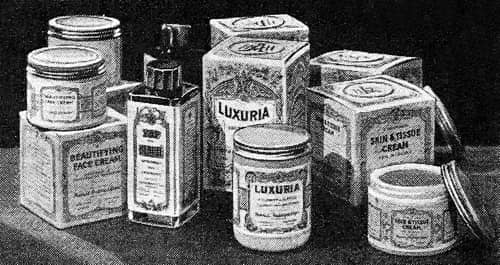
Above: 1934 Harriet Hubbard Ayer products in new packaging developed in 1933.
There were also specialist products for particular problems: Moth and Freckle Lotion for pigmentation; Honey Almond Cucumber Lotion for irritation or sunburn; and Muscle Oil, Special Astringent and/or Wrinkle Eradicator for lines and sagging contours.
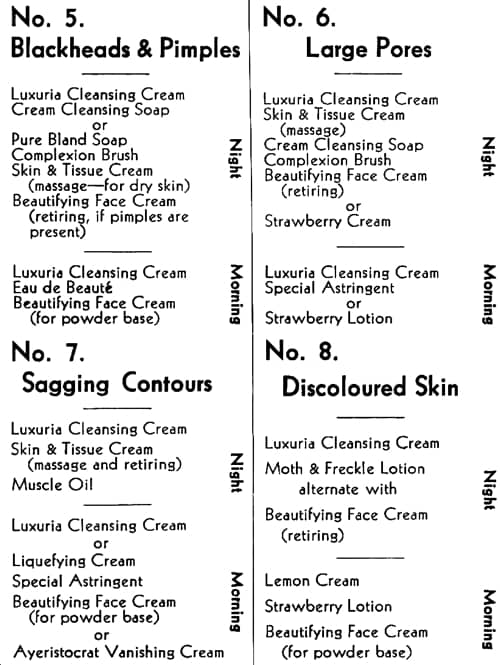
Above: 1934 Harriet Hubbard Ayer treatments for skin problems.
See also: Skin Tonics, Astringents and Toners and Muscle Oils
To comply with the 1938 U.S. Food, Drug and Cosmetic Act (FDCA), the company renamed a number of its preparations, adjusted its skin-care routines and ceased making a number of claims for products it sold in the United States. Skin and Tissue Cream became Texture Cream, Eau de Beauté was changed to Skin Tonic, Muscle Oil became Texture Oil and references to ‘feeding’ the skin were replaced with stimulating and/or lubricating. The skin-care routines after 1938 therefore became:
Normal Skin:
Night
Cleanse with Luxuria.
Lubricate with Texture Cream.
Smooth with Beautifying Face Cream.
Day
Cleanse and smooth with Luxuria.
Stimulate with Ayer Skin Lotion.
Flatter with Beautifying Make-Up Film.
Dry Skin:
Night
Cleanse with Luxuria.
Lubricate with Texture Cream and Texture Oil.
Smooth with Beautifying Face Cream.
Day
Refresh and cleanse with Luxuria.
Stimulate with Ayer Skin Lotion.
Flatter and protect with Beautifying Make-Up Film.
Oily Skin:
Night
Cleanse with Luxuria.
Wash with Ayer Cream Soap and Complexion Brush.
Dry skin thoroughly with a towel.
Day
Cleanse with Luxuria or Liquifying Cream.
Stimulate with Ayer Skin Lotion.
Flatter with Beautifying Face Cream or if the skin is very oily use finishing Lotion.
Harriet Hubbard Ayer also included an Advanced Skin Treatment for ageing skin.
Advanced Skin:
Night
Cleanse with Luxuria.
Massage with Texture Cream
Smooth on Night Cream and leave on overnight.
Day
Cleanse with Luxuria
Stimulate by patting with cotton wool saturated with Special Astringent.
Protect with Beautifying Make-up Film under powder.
Also see: Care + Color + Fragrance = Beauty (1940)
Many of these changes to the skin-care routines only applied to the United States. In other parts of the world where regulations were more lax, products such as Skin and Tissue Cream retained their original names and claims.
One aspect of interest in these skin-care regimes is that all the powder bases except Ayeristrocrat Vanishing Cream were pigmented: Beautifying Face Cream came in Flesh, Peach, Ayerbrunette and New Tan shades; Finishing Lotion in Flesh, White, Rachel, Ayerbrunette, Sun Rose, French Rachel, New Tan and Peach; and Beautifying Make-up Film in Peach and Rachel. This probably reflects the fact that Harriet Hubbard Ayer customers tended to be mature women with less than flawless complexions.
Other treatments
Particular attention was given to the throat and the eyes.
Throat
Crepey throats were the result of a lack of oil and weakness of the masseter muscle so treatment involve ‘nourishing oils’, massage to improve circulation and a combination of massage, astringents and exercises to firm up the masseter muscle.

Above: 1934 Harriet Hubbard Ayer neck exercises to improve the throat.
Eyes
The area around the eye was often the first place to show signs of fatigue or ageing. Eye Lotion was used in conjunction with an eye-cup to soothe and Night Cream was applied around the eye area and left on overnight to help reduce the signs of ageing. In 1945, Harriet Hubbard Ayer introduced an Eye Cream specifically for this purpose with eye pads and an eye mask added as ancillary treatments.
Make-up
By the end of the 1930s, Harriet Hubbard Ayer made five main face powders: Luxuria Face Powder, Beautifying Face Powder, Face Powder de Luxe, Harriet Hubbard Ayer Face Powder (previously called Harriet Hubbard Ayer Medallion Face Powder), and Ayeristocrat Face Powder (which replaced Ayeristocrat Theatrical Face Powder). There were also five additional powders distinguished by perfume: Sweet Miss Mary, Darling, Violette Petales, Red Rose and Princess Charming. All of these face powders came in the same shades: Flesh, White, Peach, Rachel, Ayerblonde, Ayerbrunette, French Rachel, and New Tan. Darker shades such as New Tan were recent additions to cater for skins browned by the new fashion for sun bathing. The downside of all this choice was the need to stock 80 different combinations of shade and powder type; a situation made worse by the addition of shades such as Rachel No. 2, Sun Rose, Yucatan Light and Yucatan Dark.
By 1940, Harriet Hubbard Ayer had rationalised its powder range leaving only Luxuria Face Powder for normal skin; Harriet Hubbard Ayer Face Powder, for dry or sensitive skin; and Ayeristocrat Face Powder for shiny skin. The specialist fragrance powders also appear to have been reduced to three, the older Red Rose and two new powders, Yu and Pink Clover based on fragrances introduced in 1937 and 1938 respectively. These perfumes were also available as colognes, toilet waters, talcum powders, soaps and other products for the bath.
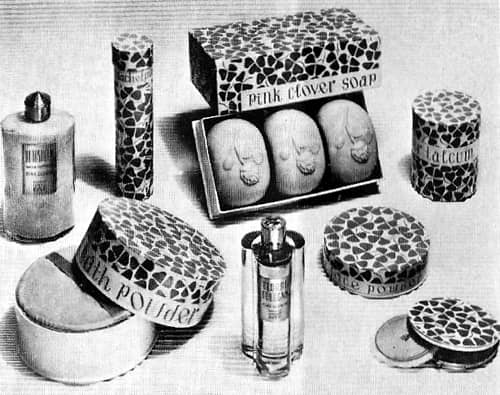
Above: 1940 Pink Clover bath products.
Women who needed to hide suntan lines could apply Complexion Balm, a liquid face powder in Flesh, White Rachel, French Rachel, and New Tan shades or use Skin Whitener, a pigmented cream used to create an even white film on the skin when going out at night.
Harriet Hubbard Ayer rouges came in three forms: La Belle Coquette Liquid Rouge in Light, Dark and Pomegranate shades; La Belle Coquette Cream Rouge in Light, Medium, Dark, Ayertitian, Ayerbrunette and Pomegranate shades; and Dry Rouge Compacts, in Light, Blonde, Blush, Pomegranate, Ayertitian, Theatrical, Flame, Medium and Dark shades. By the late 1930s the ‘ La Belle Coquette’ seems to have been dropped and the rouges are now standardised as Liquid, Cream or Dry Rouge Compacts in a wider range of shades.
Lipsticks were produced in indelible and semi-indelible formulations in push-up or twist-up cases in White, Light, Medium, Dark, Ayertitan, Ayerbrunette and Pomegranate shades. Shade ranges increased during the 1930s and were matched with rouges.
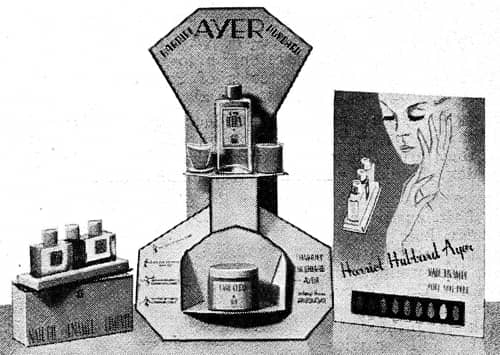
Above: 1938 Harriet Hubbard Ayer counter displays.
Eyes could be made up with Eye Shadow in Blue, Grey, Green, Brown and Orchid shades; Purmasque, a cake mascara in brown, black and blue shades; and Eyebrow Pencil in Ash Blonde, Blonde, Brown, Black and Blue shades. These colours remained pretty much the same right through the 1930s.
Over the years Harriet Hubbard Ayer use a range of color types to help women select the appropriate shade of powder, rouge, lipstick or eye make-up. Early types were based on hair colour but more complex systems evolved during the 1930s.
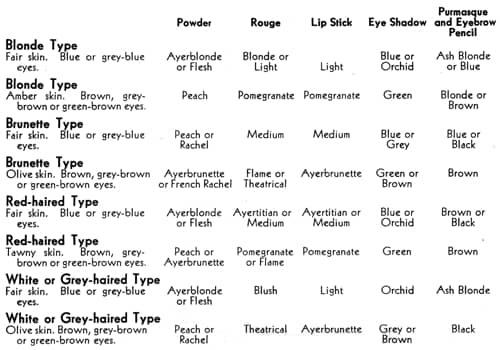
Above: 1934 Harriet Hubbard Ayer Color Harmony Make-up Chart. In 1936, an additional class was added to the Brunette Type: Tawny skin with grey or green-brown eyes.
By 1938 a simpler system with only four categories – Clear Skin, Golden Skin, Pink Skin and Red Head – was being widely used with suggestions provided for women with deep olive or suntanned skin as well. Recommended colours for these four types varied as shades were added or deleted from the range.
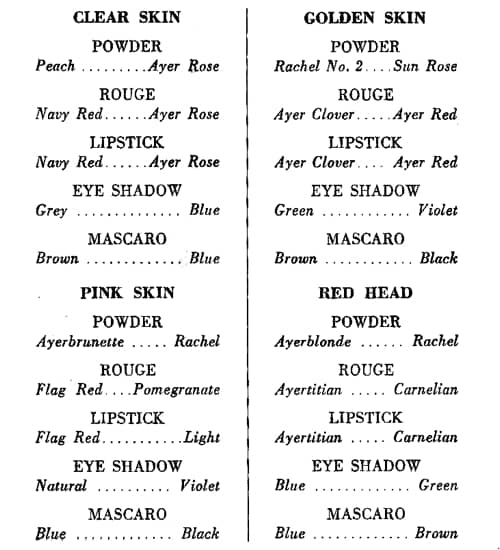
Above: 1940 Harriet Hubbard Ayer Make-up Chart.
Also see: Accent on You and Make-up Patterns
Nail-care
Harriet Hubbard Ayer sold a complete range of manicure products and equipment from the earliest days of the company. Cosmetics included Cuticle Softener, Cuticle Remover, Nail Bleach (liquid and powder), Nail Polish (powder, cake, pomade and stick), Nail Tint and Nail Enamel.
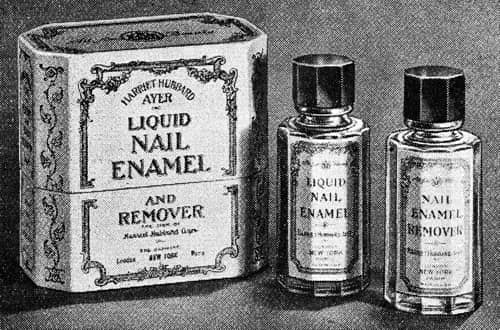
Above: 1934 Harriet Hubbard Ayer Nail Enamel and Remover. This transparent nail enamel came in Clear, Natural, Light, Medium, Cardinal, Pomegranate, and Cherry Red shades.
Early Harriet Hubbard Ayer Nail Enamels were transparent but as opaque polishes became more fashionable Harriet Hubbard Ayer introduced a Cream Nail Enamel (1935) in Natural, Light, Shell, Pomegranate, Cardinal, Tile, Medium, French Red, and Cherry Red shades.
Post war
France had been cut off during the Second World War and sales of Harriet Hubbard Ayer in Britiain were stopped in 1940. Although things were brighter in the Americas, and some new products had been developed there, the prospect of rebuilding Harriet Hubbard Ayer globally after the war must have been daunting. When coupled with the increased competition from new companies like Revlon we can see why Lillian Sefton Thomas Dodge, then nearly seventy, sold the business to Lever Brothers in 1947.
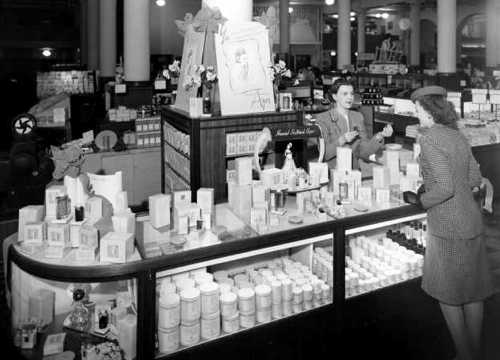
Above: 1945 Harriet Hubbard Ayer counter in Rhodes Bros. department store, Tacoma, Washington State.
Timeline
| 1907 | Harriet Hubbard Ayer founded. |
| 1911 | Business moved to 321-323 East Street, New York. |
| 1918 | Vincent B. Thomas dies. |
| n.d. | Harriet Hubbard Ayer established at 33 Boulevard Haussmann, Paris. |
| 1923 | New Products: Luxuria Face Powder. |
| 1928 | Sefton-Dodge Ltd. established at 150 Regent Street, London. |
| 1930 | Sefton-Dodge Ltd (U.K.). renamed Harriet Hubbard Ayer Ltd. London operations moved to 130 Regent Street. |
| 1932 | Harriet Hubbard Ayer begins direct selling to retailers. |
| 1933 | Harriet Hubbard Ayer creams repackaged. |
| 1935 | Harriet Hubbard Ayer face powders repackaged. New Products: Beautifying Face Powder; and Ayer Cream Nail Enamel. |
| 1936 | Salon treatments begin at 130 Regent Street, London. |
| 1937 | New Products: Nail Oil; Afterbath Lotion; and Aftershave Lotion. |
| 1938 | Salon de Massage opens at 33 Boulevard Haussmann, Paris. |
| 1940 | British sales of Harriet Hubbard Ayer stop. |
| 1941 | New Products: Beautifying Mask and Bubbling Bath. |
| 1944 | New Products: Ayeristocrat Sponge-on Make-up. |
| 1945 | New Products: Eye Cream; and Ayer Dry antiperspirant. |
| 1947 | Lever Brothers acquires Harriet Hubbard Ayer. |
Continued to: Harriet Hubbard Ayer (post 1947)
First Posted: 30th March 2016
Last Update: 20th July 2022
Sources
The American perfumer & essential oil review. (1906-1955). New York: Robbins Perfumer Co. [etc.].
Blaugrund, A. (2011). Dispensing beauty in New York & beyond. The triumphs and tragedies of Harriet Hubbard Ayer. Charleston: The History Press.
The Chemist and Druggist. (1859-). London: Morgan Brothers.
Harriet Hubbard Ayer Inc. (1933). Beauty under twenty [Booklet]. USA: Author.
Harriet Hubbard Ayer Ltd. (1934). Beauty for all [Booklet]. Montreal: Author.
Harriet Hubbard Ayer Inc. (1938). Accent on you [Booklet]. USA: Author.
Harriet Hubbard Ayer Inc. (n.d.). Make-up patterns [Pamphlet]. Author.
Harriet Hubbard Ayer Inc. (1940). Care + color + fragrance = beauty [Booklet]. USA: Author.

Vincent Benjamin Thomas [1868-1918].

1916 Harriet Hubbard Ayer Toilet Preparations.
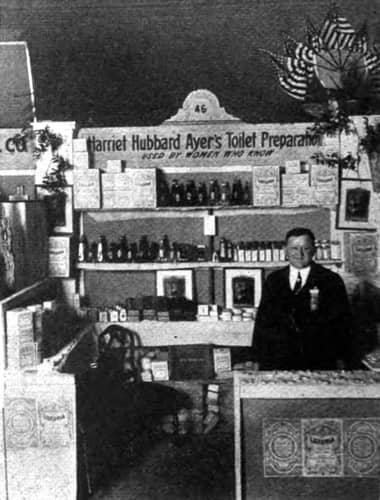
1917 Harriet Hubbard Ayer Toilet Preparations stand at a Cleveland trade show.
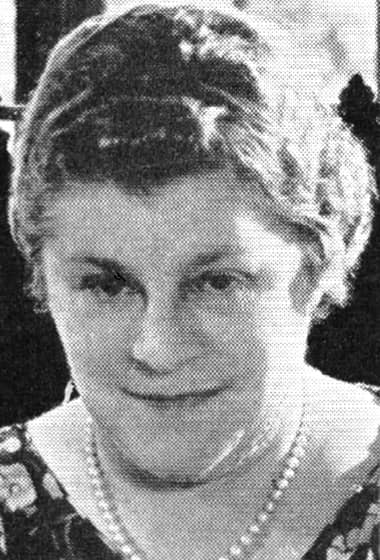
Lillian Sefton Thomas Dodge [1877-1960].

1920 Harriet Hubbard Ayer Toilet Preparations.
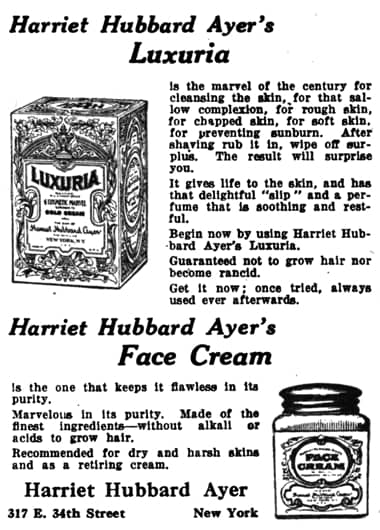
1922 Harriet Hubbard Ayer Luxuria and Harriet Hubbard Ayer Face Cream trade advertisement.

Harriet Hubbard Ayer at 317-323 East 34th Street, New York. The company moved here from 1 West 34th Street in 1911. The building still stands today.

Harriet Hubbard Ayer Skin & Tissue Builder.

1924 Harriet Hubbard Ayer, Paris.

1925 Harriet Hubbard Ayer, Paris.
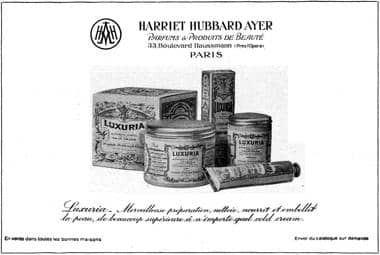
1926 Harriet Hubbard Ayer, Paris.
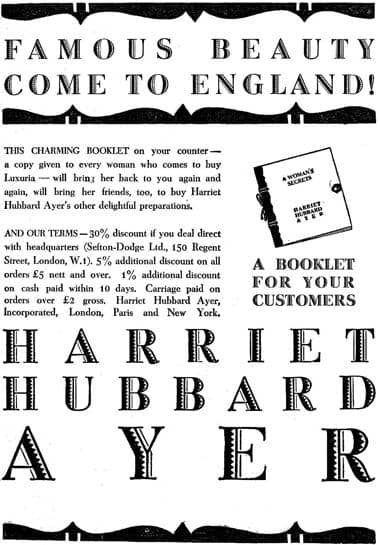
1928 Part of a trade advertisement announcing the arrival of Harriet Hubbard Ayer.
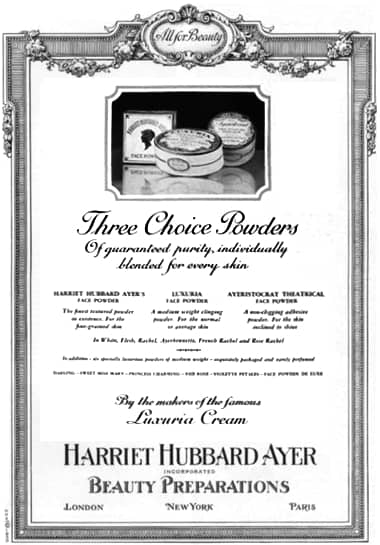
1930 Harriet Hubbard Ayer Face Powder, Luxuria Face Powder and Ayeristocrat Theatrical Face Powder.
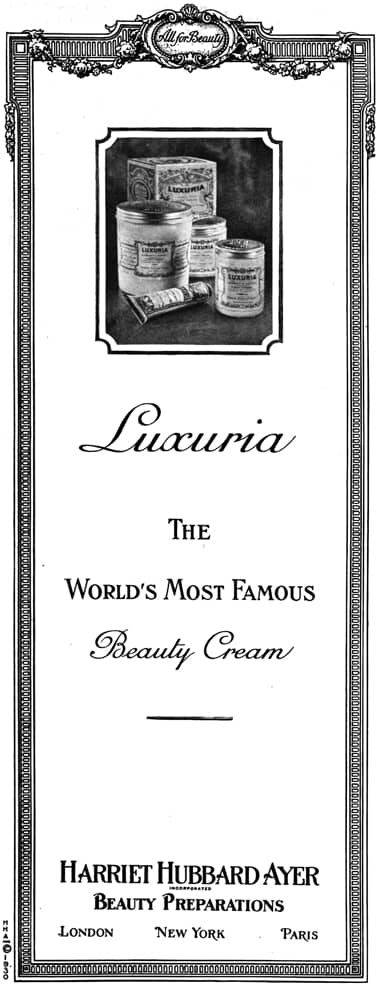
1930 Harriet Hubbard Ayer Luxuria Cream.

1931 Harriet Hubbard Ayer Ayeristocrat Theatrical Face Powder, Luxuria, Almond Honey Cucumber Lotion, and Beautifying Face Cream.
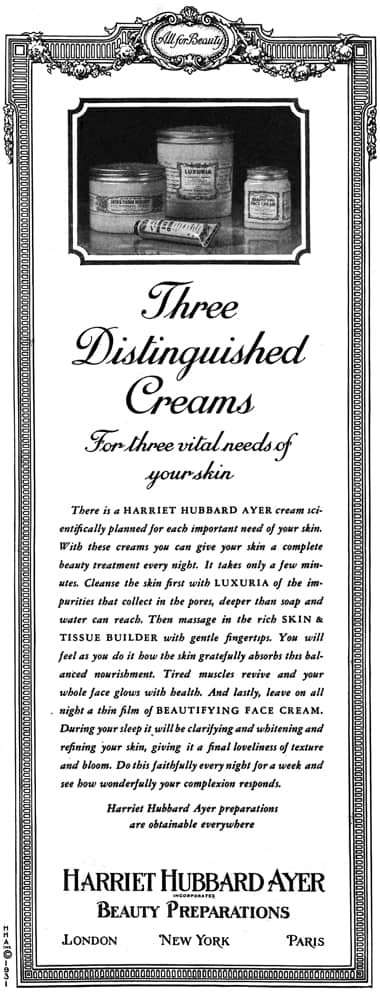
1931 Harriet Hubbard Ayer Luxuria, Skin & Tissue Cream and Beautifying Face Cream.
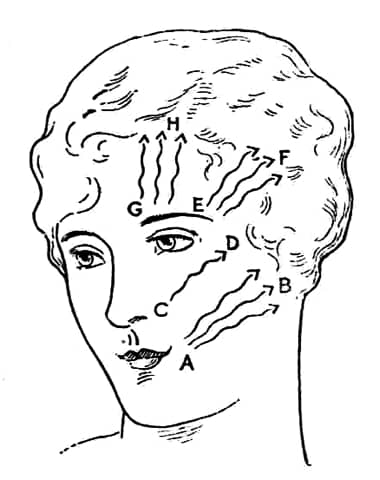
1934 Harriet Hubbard Ayer massage movements.
“While the muscles are being aroused and the circulation stimulated, Nature must be aided by a pure, wholesome, penetrating
cream that will aid in replenishing the underlying tissues, in making them fresh, supple, vibrant. Therefore, the HARRIET HUBBARD AYER SKIN AND TISSUE CREAM should be used in generous quantities …. This cream, rich, luscious, fragrant—smooth as silk—will work with you as your fingers glide over your skin, giving new life to the flaccid tissues, strengthening the muscles, helping Nature throughout.
Before beginning these exercises it must be understood that the word massage means ‘a system of remedial treatment.’ It is not to be interpreted as a vigorous and energetic dragging of the flesh, but a gentle, persuasive manipulation with the cushions of the fingers. All movements must be upward and outward. The movement itself is semi-rotary; crawling, moving in half circles without removing the fingers, pressing them very gently, but quite firmly, into the skin” (Harriet Hubbard Ayer Ltd., 1934, p. 42).

1935 Harriet Hubbard Ayer face powders. Princess Charming, Sweet Miss Mary, Red Rose and Darling are distinguished by their perfume.

1935 Harriet Hubbard Ayer Luxuria, Skin & Tissue Cream and Beautifying Face Cream.
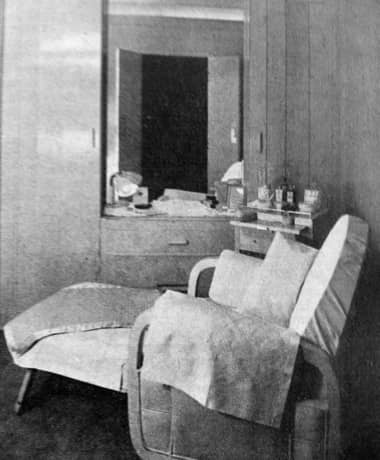
1936 Treatment room at the London salon of Harriet Hubbard Ayer.
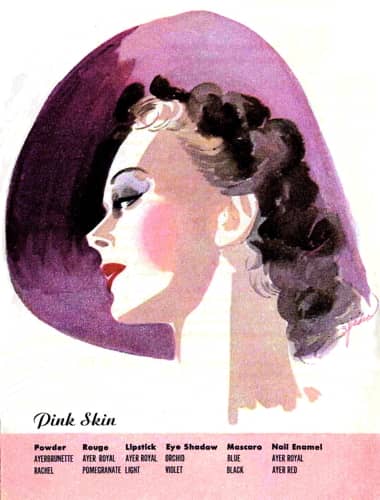

1938 Recommended make-up for Pink Skin.
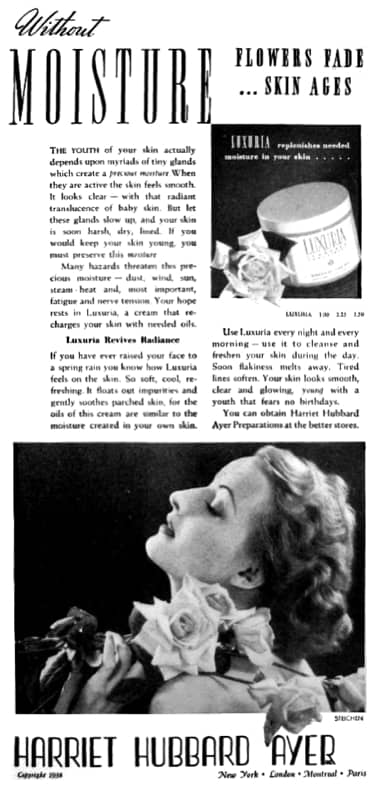
1938 Harriet Hubbard Ayer Luxuria Cream.

1940 Harriet Hubbard Ayer Eye Lotion, Eye-cup and Night Cream. The Night Cream was replaced with Eye Cream in 1945.
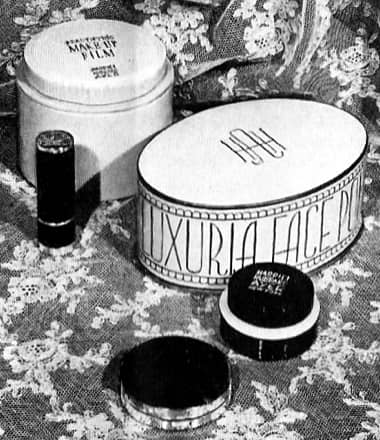
1940 Harriet Hubbard Ayer Make-up Film, Lipstick, Luxuria Face Powder, and rouge.
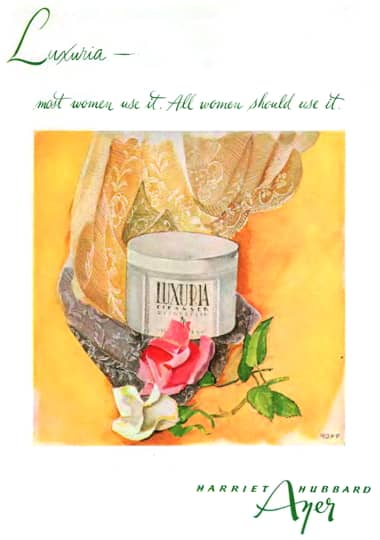
1943 Harriet Hubbard Ayer Luxuria Cream.
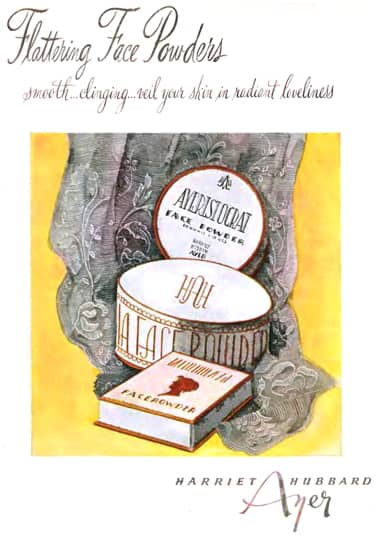
1944 Harriet Hubbard Ayer Face Powders.
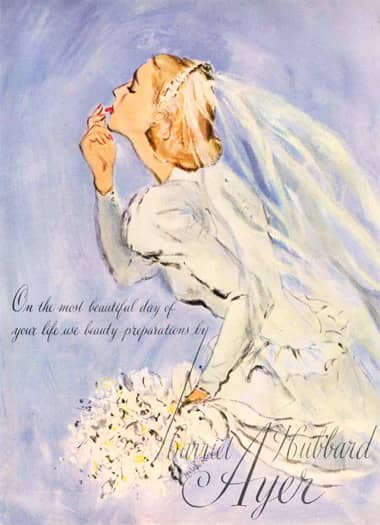
1945 Harriet Hubbard Ayer.
